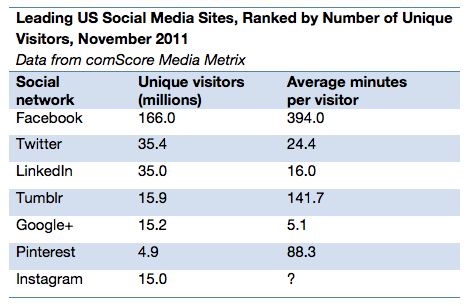
Digital marketers, and now Wall Street, are cashing in on major social platforms like Facebook, LinkedIn and Twitter. But nipping at the heels of these wildly successful services is a new generation of social networks. Catering to niche audiences with visual appeal and lightweight web and app-based clients, these networks hold great potential for marketers.
And with new social networks come new challenges. Adding yet another social tactic into the marketing mix can seem daunting to professionals just now gaining a foothold on older, more established platforms.
Let’s take a look at the latest developments in four fringe social platforms and proposes tactics and real-world examples for utilizing them to successfully connecting with consumers.
Size matters
In the world of social networks, size and engagement are everything. Without a critical mass of engaged users networks cannot monetize. Today, older, more established companies dominate the playing field. That’s an important distinction for marketers to make, and the reason why we chose to lead with this data point.

Facebook leads the pack but may be slowing down
According to data released by Facebook, the final quarter of 2011 saw 45 million regular users – defined as members who accessed Facebook in the last 30 days – added to the service. And while that number may seem large, it’s the smallest increase for the social giant in nearly two years. While the reason for the slowdown is difficult to assess it does serve as a reminder – social networks have come and gone in the past. Low barriers to entry and pressure to innovate mean a stream of competitors for the social king of the hill.
Twitter’s future still uncertain
The staggering growth of the microblogging platform and social network Twitter has been offset by an uncertain future and ambiguous revenue model from advertising. eMarketer predicts revenue from advertising will rise to $540 million in 2014 from $139.5 million in 2011 based on international expansion and increasing domestic advertising appetites. Speculation aside, data on engagement and active accounts remains mired in fake accounts and hundreds of software products that duplicate the website experience. In recent weeks Quantas, Microsoft and a US Senator were high profile victims of separate Twitter incidents, proving the platform may face challenges with marketers willing to spend advertising dollars chasing after what are essentially non-existent profiles.
LinkedIn adds new users at a steady pace
A recent report from LinkedIn notes that 14 million profiles were added in the final quarter of 2011, bringing its total to 145 million. New features and dramatic growth in advertising revenue point to a strong 2012 for the largest social network for professionals. In addition, LinkedIn has recently released a feature allowing companies to embed a “Like” button. Similar to Facebook and Twitter, the new feature will encourage more professionals to engage with brands on the LinkedIn platform and serve as another mechanism to drive revenue through upgraded company profiles.
Tumblr maintains small size with big engagement
Blogging stalwart Tumblr has proven that a light interface combined with customizable elements leads to high engagement. Though user base is small compared to top social media contenders, the future may hold growth. Though not currently monetized, Tumblr is seeking to begin drawing revenue from advertising. The plan and timeframe for execution are unclear, and the company is openly searching for an executive to lead the ad sales charge.
Google+ shows weak engagement numbers despite signup quantity
Adding traffic is only part of the social equation. True user interest can be measured by time on site, clicks, sharing action and other metrics indicating engagement with a social platform. And in that bucket of activities Google+ seems to be falling short. The newest major entrant also faces a big challenge: direct competition with Facebook, Twitter and LinkedIn. While Google backing does afford a limited need to demonstrate profitability, a lack of original features may be making it difficult for the fledgling network to steal attention from incumbent competitors.
Pinterest and Instagram offer niche simplicity
Visual stimulation seems to be a significant unmet consumer need in 2012. Social networks Pinterest and Instagram both offer unique and simple ways to discover and share imagery with connections. While Pinterest focuses on organizing preexisting still images into groups on a desktop computer, Instagram encourages users to take pictures with a mobile device, apply unique visual effects and share them online. Their popularity and rapid growth demonstrate the power of online images and prove that a social network does not have to be feature rich to garner significant engagement figures.
Shiny Object Syndrome
New networks mean new distractions for marketers. Successfully connecting with consumers in the social space includes driving awareness, engagement, conversions and sales. That takes time. By focusing on the networks that matter most, marketers can avoid falling victim to shiny object syndrome while building lasting value.